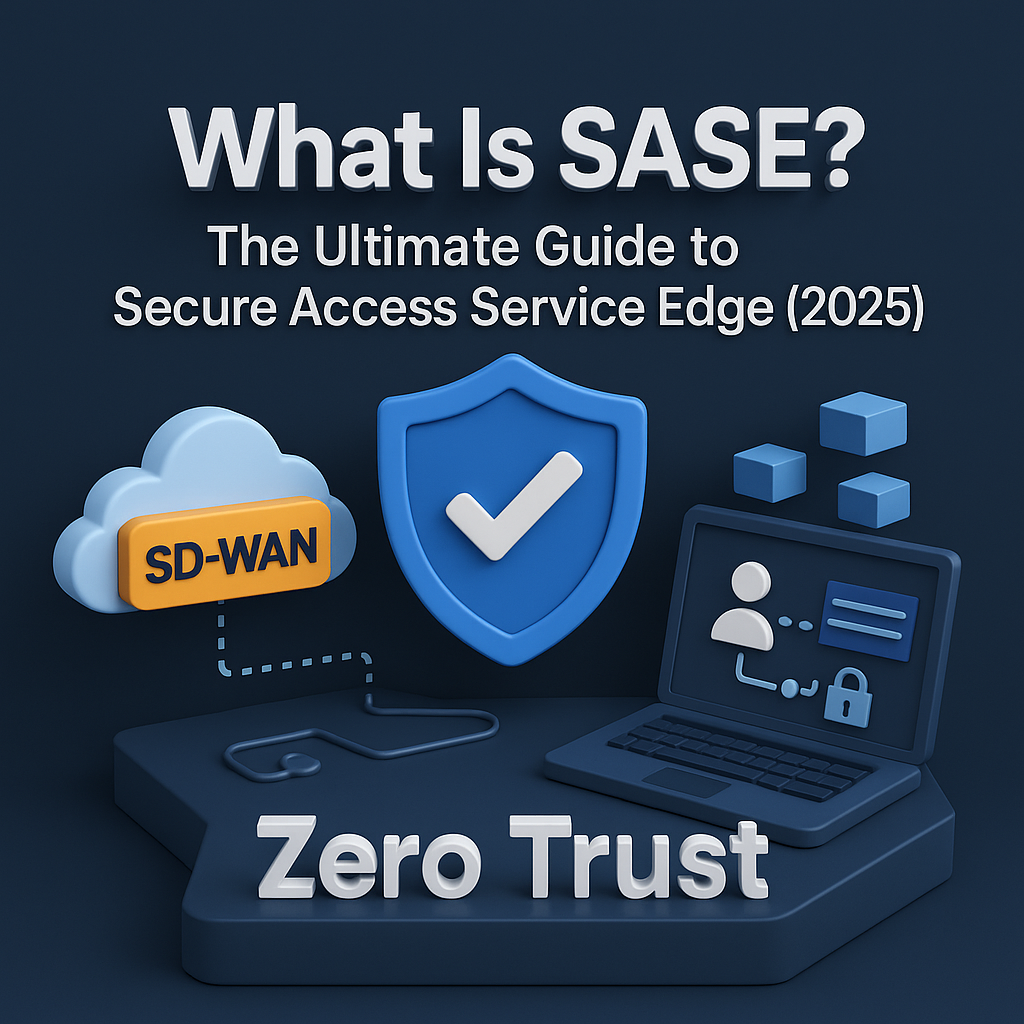Let’s face it: enterprise networking used to be a hot mess of cables, MPLS contracts, VPNs that felt like dial-up, and a security stack built like Jenga. Then came SASE (pronounced “sassy”) to clean things up.
So what is SASE?
SASE, or Secure Access Service Edge, is a cloud-native architecture that converges networking and security into a single service, delivered mostly from the cloud. Instead of backhauling all your traffic to a central data center to filter it, SASE moves those capabilities to the edge, close to where users, devices, and apps actually live.
It’s like moving from an old-school office switchboard to an AI-powered call router that works from anywhere. No more slow connections, clunky firewalls, or having to explain to your boss why the VPN went down right before that big call.
And because I know someone out there will ask: no, this isn’t just SD-WAN with lipstick. It’s a whole new model. Let’s unpack it.
What Is SASE Security (and Why It’s Not Just a Fancy Firewall)
SASE security means you’re getting more than just perimeter protection—it’s about enforcing security policies anywhere your users are, across any device or app, without relying on outdated hardware.
A standard SASE stack (according to Gartner) includes:
- SD-WAN: Smart routing and bandwidth control
- SWG (Secure Web Gateway): Filters dangerous traffic
- CASB (Cloud Access Security Broker): Governs SaaS usage
- ZTNA (Zero Trust Network Access): Replaces traditional VPNs
- FWaaS (Firewall-as-a-Service): Next-gen firewall features in the cloud
All of this gets deployed close to the user—usually from globally distributed Points of Presence (PoPs)—so your security is fast, scalable, and location-agnostic.
Vendors like Palo Alto Networks, Fortinet, and Zscaler are leading the charge, each with different flavors of how they deliver this magic. But at the end of the day, SASE security is about making sure you’re protected before something bad happens, not scrambling after the fact.
What Is SASE in Cyber Security?
Here’s the thing: cybersecurity isn’t just about keeping the bad guys out anymore—it’s about making sure users can securely connect to the things they need, without giving them keys to the whole kingdom.
That’s where SASE fits in. In the world of cyber security, SASE combines the principles of Zero Trust (never trust, always verify) with a distributed security perimeter. Instead of securing “the network,” you secure every access event based on user identity, device posture, location, and context.
Got a remote dev team using GitHub, Slack, Salesforce, and random open Wi-Fi? Great. SASE ensures they can work safely without routing everything through a crusty VPN gateway. Think of it as replacing a moat-and-castle security model with biometric locks on every door.
And it’s working. As of 2025, 60% of enterprises have a formal SASE strategy, up from just 10% in 2020. Cybersecurity has officially gone edge-first.
What Is SASE Architecture?
Think of SASE architecture as building your network and security stack like a modern cloud app—modular, distributed, and API-friendly.
It merges two previously distinct domains:
- Networking (SD-WAN): Handling routing, bandwidth, redundancy
- Security Services (SSE): SWG, ZTNA, CASB, FWaaS
You can deploy it via a single vendor (more integrated, faster rollout) or multi-vendor approach (more customizable, possibly more complex).
SASE architecture also depends heavily on having global PoPs—nodes that deliver all that functionality near users. These reduce latency, improve UX, and ensure policies are enforced no matter where someone connects from.
In a nutshell: you stop thinking about security appliances and start thinking about policy orchestration from the cloud. It’s Lego, but for grown-up security nerds.
What Is SASE Network?
A SASE network isn’t a specific topology—it’s more like a philosophy baked into how you connect users, devices, and data.
You’re basically doing this:
- Replace private MPLS with smart SD-WAN
- Push out security to the edge (via cloud PoPs)
- Route traffic intelligently based on context
- Enforce policy everywhere, not just at HQ
The result? A resilient, scalable, high-performance network that’s inherently secure. It’s also optimized for cloud-native apps, hybrid workforces, and branch connectivity without buying truckloads of hardware.
And for the record: SASE is what happens when network engineering and security architecture finally sit down and agree on something.
What Is the Goal of SASE?
The goal of SASE is pretty simple: give users secure, fast, reliable access to whatever they need—wherever they are—without compromising on performance or adding unnecessary complexity.
This means:
- Killing off legacy VPNs and hub-and-spoke bottlenecks
- Making your remote work strategy actually work
- Giving IT teams centralized policy control
- Making security proactive, not reactive
It also means serious ROI. Forrester found companies saw up to 270% return on investment, while others reported $250K+ annual savings and major reductions in NetOps time.
In other words, it’s not just a buzzword. It’s a strategy with bottom-line impact.
Bonus: SFTP vs MFT (Why It Matters in the SASE Conversation)
If you’re talking about secure file transfer in the age of cloud-first security, you’ll hear two acronyms thrown around a lot: SFTP and MFT.
- SFTP (SSH File Transfer Protocol): Basic, secure file transfer over SSH. Great for point-to-point transfers, but lacks advanced features.
- MFT (Managed File Transfer): Enterprise-grade, policy-based transfer with auditing, automation, compliance tools, and SASE-ready integrations.
In the SASE world, MFT wins—because it aligns with the Zero Trust mindset. You’re not just sending files; you’re managing the who/what/when/where/why of every transfer.
TL;DR: If SFTP is a paper airplane, MFT is a secure drone with flight logs and a no-fly-zone map.
The SASE Market in Numbers: 2024–2025
Let’s talk real numbers. According to Grand View Research and Dell’Oro, the global SASE market will hit $17+ billion by 2029–2030, with a blazing-fast CAGR of up to 27.2%.
Here’s what’s fueling that:
- 60% of enterprises will have a formal SASE strategy by 2025
- 70% of IT execs see SD-WAN + SASE convergence as critical (Aryaka)
- Single-vendor platforms now account for 80% of revenue in the space (SDX Central)
- Vendors like Palo Alto Networks, Fortinet, Zscaler dominate Gartner’s Magic Quadrant
- Average reported ROI from real-world deployments? Between 113% and 270%
Needless to say, this isn’t some niche experiment—it’s the future of secure connectivity.
Rolling Out SASE: A Field-Tested Playbook
Phase 0: Reality Check
Before you even talk to a vendor, take inventory. What do you already have in place? MPLS contracts? Aging firewalls? Spaghetti DNS? Map every branch, cloud workload, remote user, and security control.
Track your current latency, bandwidth, appliance lifecycle, and licensing contracts. These metrics will come in handy when you need to prove SASE made life better (and not just more expensive).
Pro tip: The best SASE migrations piggyback on existing refresh cycles—firewall EOL, new SaaS onboarding, or MPLS renewals.
Phase 1: Architecture Path
Decision Type | Single-Vendor SASE | Dual Stack (SD-WAN + SSE) |
Time-to-value | Fastest | Slower |
Feature scope | Sometimes limited | Best-of-breed flexibility |
Budgeting | Subscription model | Mix of OpEx/CapEx |
If you’re in it for the long game, Gartner recommends converging toward a single cloud-native edge architecture—even if you phase it in gradually.
Phase 2: Vendor Shortlisting Checklist
- ✅ Global PoP presence (100+ with coverage near your users)
- ✅ <100ms proxy/edge latency at 95th percentile
- ✅ Full stack: SD-WAN, SWG, CASB, ZTNA, FWaaS
- ✅ Identity integrations: SAML/OIDC, SCIM, MFA APIs
- ✅ Real-time telemetry: SIEM/SOAR support, DEM agents
- ✅ Compliance: SOC 2, ISO 27001, GDPR, regional standards
- ✅ Flexible contract levers: burst licensing, BYOL support
Run this list against Gartner MQs and Forrester Waves to narrow the field.
Phase 3: Pilot
Scope: 1 branch + 50 remote users
- Duration: 4–6 weeks
- Goals: ≤5ms added latency, zero policy violations
Run DEM probes. Simulate break/fix scenarios. Measure QoE. Make sure you can revoke access from a stolen laptop in under 60 seconds.
Phase 4: Expansion + Security Fold-In
- Duration: 3–6 months (network) + 2–4 months (security stack)
- Actions:
- Retire MPLS
- Deploy SWG → CASB → ZTNA in layers
- Benchmark cost savings, shadow IT visibility, and app performance
- Retire MPLS
Phase 5: Optimization
- KPIs to monitor:
- ⬇️ 20% WAN costs per site
- ⬇️ 50% appliance count within 12 months
- <30 min MTTR on incidents
- <0.5% policy miss rate
- ≥95% coverage on shadow IT detection
- ⬇️ 20% WAN costs per site
Common SASE Pitfalls (and How to Dodge Them)
Pitfall | Quick Fix |
Copy-pasting legacy firewall rules into the cloud | Rebaseline. Start with least-privilege ZTNA and clean up as you go |
Undersized edge bandwidth | Run PoP load tests pre-migration. Add redundancy where needed |
Treating it like just another network upgrade | Bring in security, compliance, and desktop teams from Day 0 |
Ignoring QoS policies for real-time apps | Use SD-WAN rules for Teams, Zoom, etc. |
RFP Questions That Actually Matter
- “List every PoP within 250km of Tel Aviv and backbone provider”
- “Provide audited 95th percentile latency logs for Q1 2025”
- “Describe how your ZTNA agent enforces device posture checks”
- “Offer migration tooling for ASA / FortiGate rule translation”
- “What’s your license model for burst users and seasonal spikes?”
Final Word
SASE is 30% technology, 70% project management, and 100% the future of secure enterprise networking. Roll it out with a clear playbook, measure what matters, and retire that ancient VPN appliance with a small ceremony and a donut.
Because secure, scalable, cloud-native access shouldn’t be hard—and with SASE, it doesn’t have to be.





